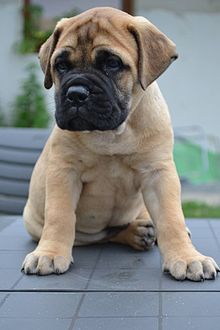Bullmastiff
| Bullmastiff Dog | |||||||||||||||||||||||||
|---|---|---|---|---|---|---|---|---|---|---|---|---|---|---|---|---|---|---|---|---|---|---|---|---|---|
 | |||||||||||||||||||||||||
| Origin | England | ||||||||||||||||||||||||
| |||||||||||||||||||||||||
| |||||||||||||||||||||||||
| Dog (domestic dog) | |||||||||||||||||||||||||
The Bullmastiff is an English breed of dog of mastiff type and large size, with a solid build and a short muzzle. It was developed as a guard dog in the nineteenth century by cross-breeding the English Mastiff with the now-extinct Old English Bulldog. It was recognised as a breed by The Kennel Club in 1924.
History
[edit]The origins of the Bullmastiff are unclear. In the 18th century, in some regions of England, the English Mastiff and Old English Bulldog were commonly inter-bred to produce dogs suitable for guarding people and their property. By the beginning of the 20th century, this cross-breed was in widespread use as an aid to gamekeepers in the control of poaching.[2] They were bred for strength, size and speed using a cross of the tough, heavy and aggressive 19th century Bulldog with the large, strong, less aggressive Mastiff.[3] As a result, the Bullmastiff is known as the Gamekeeper's Night Dog.
The Bullmastiff was recognised as a breed by The Kennel Club in 1924. Dogs had to have a minimum of four generations of descent from Bullmastiff stock without input from either Bulldog or Mastiff; cross-bred animals could not be registered.[2] The American Kennel Club recognised it in 1934.[4]
It was definitively accepted by the Fédération Cynologique Internationale in 1955.[5]
In 1928, the De Beers diamond mining company imported Bullmastiffs to South Africa to guard the mines.[6]
Appearance
[edit]



The Bullmastiff is a large dog. Bitches stand some 61–66 cm at the withers, and usually weigh 41–50 kg; on average, dogs stand about 3 cm taller and weigh 9 kg more.[1]
The coat may be fawn, red or brindle, in any shade; some limited white marking on the chest is allowed. The muzzle is black, becoming paler towards the eyes.[1]
The Bullmastiff is brachycephalic, flat-faced and short-muzzled, but this does not affect its breathing.[7][failed verification]
Health
[edit]A 2024 UK study found a life expectancy of 10.2 years for the breed compared to an average of 12.7 for purebreeds and 12 for crossbreeds.[8]
Health concerns within the breed include hip and elbow dysplasia, progressive retinal atrophy, bloat, and cancer, with a relatively high incidence of lymphoma and mast cell tumours.[9][10][11] Bullmastiffs are prone to certain hereditary diseases, including:
- Hip dysplasia, affecting 24.5% of individuals [12]
- Elbow dysplasia, affecting 13.8% of individuals,[13]
- Entropion, hypothyroidism affecting 2.8% of individuals,[14]
- Lymphoma
An autosomal dominant form of progressive retinal atrophy is common in the breed. A mutation to the RHO gene is responsible.[15]
See also
[edit]References
[edit]- ^ a b c d e f FCI-Standard N° 157: Bullmastiff. Fédération Cynologique Internationale. Accessed February 2022.
- ^ a b Eric Makins ([1938]). The Bullmastiff. Manchester: 'Our Dogs' Publishing Co.
- ^ Walkey B. The Bullmastiff Fancier's Manual. Sechelt B.C., Canada: Coast Arts Publishing; 1992
- ^ Get to Know the Bullmastiff. The American Kennel Club. Retrieved 29 May 2014.
- ^ FCI breeds nomenclature: Bullmastiff (157). Fédération Cynologique Internationale. Accessed February 2022.
- ^ "Breed standard (Appendix A)" (PDF). Sabt.co.za. Archived from the original (PDF) on 16 August 2012. Retrieved 18 September 2012.
- ^ Brachycephalic dogs. The Kennel Club.
- ^ McMillan, Kirsten M.; Bielby, Jon; Williams, Carys L.; Upjohn, Melissa M.; Casey, Rachel A.; Christley, Robert M. (1 February 2024). "Longevity of companion dog breeds: those at risk from early death". Scientific Reports. 14 (1). Springer Science and Business Media LLC. doi:10.1038/s41598-023-50458-w. ISSN 2045-2322. PMC 10834484.
- ^ Bell J, Cavanagh K, Tilley L, Smith FWK. Veterinary Medical Guide to Dog and Cat Breeds. Hoboken: Teton NewMedia; 2012.
- ^ Edwards DS, Henley WE, Harding EF, Dobson JM, Wood JLN (2003). "Breed incidence of lymphoma in a UK population of insured dogs". Veterinary and Comparative Oncology. 1 (4): 200–6. doi:10.1111/j.1476-5810.2003.00025.x. PMID 19379181.
{{cite journal}}: CS1 maint: multiple names: authors list (link) - ^ Dobson JM (2013). "Breed-predisposition to cancer in pedigree dogs". ISRN Veterinary Science. 2013: 1–23. doi:10.1155/2013/941275. PMC 3658424. PMID 23738139.
- ^ Orthopedic Foundation for Animals. "Hip Dysplasia Statistics". Archived from the original on 19 October 2010. Retrieved 11 June 2013.
- ^ Orthopedic Foundation for Animals. "Elbow Dysplasia Statistics". Archived from the original on 3 September 2011. Retrieved 11 June 2013.
- ^ Orthopedic Foundation for Animals. "Thyroid Statistics". Archived from the original on 30 May 2013. Retrieved 11 June 2013.
- ^ Oliver, James A.C.; Mellersh, Cathryn S. (2020). "Genetics". In Cooper, Barbara; Mullineaux, Elizabeth; Turner, Lynn (eds.). BSAVA Textbook of Veterinary Nursing (Sixth ed.). British Small Animal Veterinary Association. p. 131. ISBN 978-1-910-44339-2.
